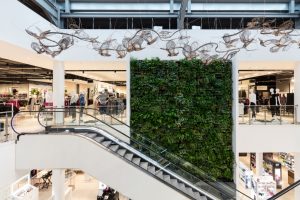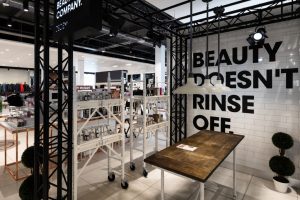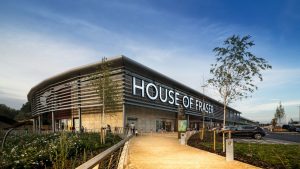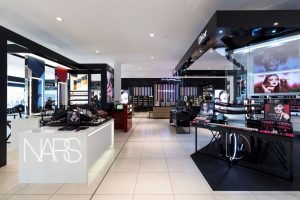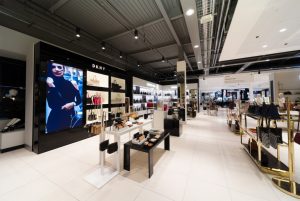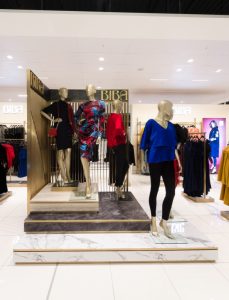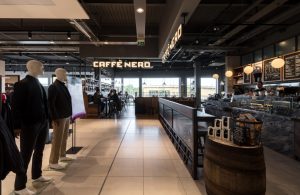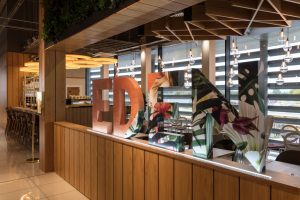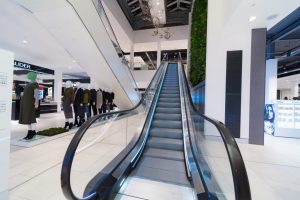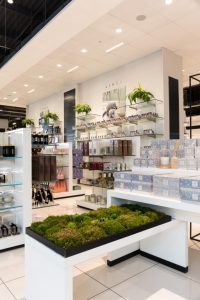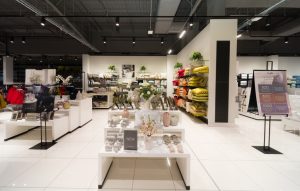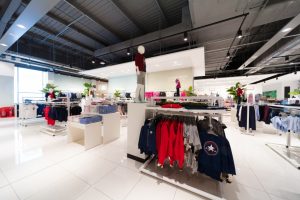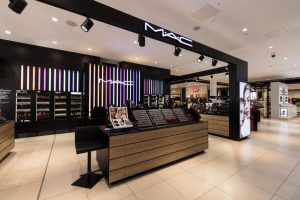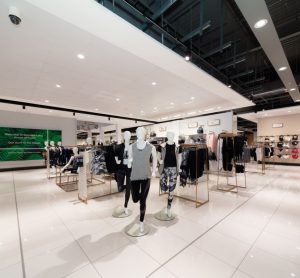London-based House of Fraser’s new store at Rushden Lakes Shopping Centre in Northamptonshire, U.K., 70 miles northeast of London, is the British department store retailer’s first new location in nearly 10 years.
A decade is an eternity for a retail industry in such dramatic transformation. So Kinnersley Kent Design (KKD), the London-based firm responsible for the project, created a new store for a new world.
For one thing, says Mick Kent, KKD co-founder and partner, it’s the retailer’s first store that’s not on an urban high street or in a city center. For another, at two floors and 80,000 square feet, it’s roughly half the size of a traditional House of Fraser store.
To cram the usual product assortment into half the space would lead to dense merchandising, so House of Fraser didn’t try. Rather, says Kent, there are capsule collections of beauty, cosmetics and fashion, enough to satisfy the local market that once had to travel into London for such merchandise.
“In today’s department store world, it’s all about creating that worthwhile experience,” says Sandy Stein, president and design director of Stein Branding, Trending, Design (St. Paul, Minn.). “There has to be some reason to go to the store, and it can’t just be to buy stuff.”
For House of Fraser, that meant a nod to the local environment. Rushden Lakes is in the Nene Wetlands nature reserve, a picturesque conservatory of water and greenery with a wildlife and bird sanctuary.
Advertisement
The store is BREEAM (Building Research Establishment Environmental Assessment and Management) compliant; BREEAM is the British version of LEED. It has a 50 percent-reduced carbon footprint, thanks to LEDs throughout, eco-friendly “comfort cooling” – through perforated air-displacement walls – instead of standard air conditioning and a 160-square-foot living wall, consisting of nearly 2000 plants, in the heart of the store.
House of Fraser partnered with the local Wildlife Trust to provide customers guided walks around the lakes, wildlife gardening and children’s craft activities.
It’s not just nature, however, that draws shoppers. There are more than 50 premium brands in store, as well as a champagne bar, restaurant and coffee shop. “It’s an aspirational environment,” Kent says. “While it’s not the usual city center flagship experience, the high-level brands make it feel just as glamorous.”
“Brands can no longer just represent products, but need to stand for something credible and believable,” KKD Partner Jill Higgins wrote in a 2017 white paper, “Retail Spaces: Putting the Customer at the Heart of the Experience.” She says, “Never before has ‘brand’ been such an important differentiator between retailers. Each brand needs a distinct philosophy that sets it apart from competitors and makes it an easy choice for target customers.”
Stein sees opportunities for American department stores to achieve that distinction. For JCPenney Co. Inc. (Plano, Texas), that might mean returning to the hard lines that once made it an industry leader. Perhaps not for nothing, CEO Marvin Ellison is a former Home Depot (Atlanta) executive.
“With Sears’ store closings,” Stein says, “there’s a wide-open door to pick up all that appliance business.”
Advertisement
But not just by selling product, Stein believes. There’s also an opportunity to serve, consult, contract, install – “an end-to-end offering.”
For example, he says, today’s aging-in-place phenomenon requires ramps, special baths and showers, chair lifts, safety bars, in-home monitors and communications devices, as well as energy-efficient HVAC systems.
“If Penney’s can become a facilitator of [these types of products and services], people will think about them when they need a furnace or boiler or air conditioning or solar panels,” says Stein. “It’s creating a niche that goes beyond just selling somebody something.”
VMSD New York Editor/Editorial Advisor Eric Feigenbaum agrees with department stores’ need to stand for something. As they create smaller footprints, “the square footage becomes more vital, and it has to be more compelling, exciting, engaging,” says Feigenbaum, who was corporate director of visual merchandising at Stern’s Department Store (Paramus, N.J.) in the 1980s and ’90s. “Don’t think about transaction, think about interaction. The term once was p-o-s, point of sale. Now it’s p-o-e, point of experience. That has to mean social engagement, experiences and education – events, lectures, demonstrations, parties, art shows.”
Feigenbaum calls out Bloomingdale’s Ala Moana store in Honolulu that opened two years ago (featured in VMSD’s February 2016 issue). “It’s very contemporary and celebrates the locale,” he says. “When you walk in, you know it’s a Hawaiian store, integrating contemporary Hawaiian art, food and culture.”
Stein points to the Palacio de Hierro store in the upscale Polanco district of Mexico City, completed by Gensler (San Francisco) in 2015. It’s full of architectural references to local landmarks, such as a main floor avenue for cosmetics, perfume and accessories that references Paseo de la Reforma, a main artery which runs through the heart of Mexico City. On the first floor, the women’s department is designed after Lomas de Chapultepec, an exclusive Mexico City neighborhood, and the children’s department is full of allusions to Feria de Chapultepec, a Mexico City amusement park.
Advertisement
“There was a time when department stores catered to their local population,” says Stein, “but all of the mergers and acquisitions began to eliminate those local references.
“We’re at a time when authenticity is becoming more important, and in too many cases the retailers are making it less important.”
That is the challenge, but also the opportunity, Stein feels. “Department stores have to ask themselves new questions, like, ‘What’s relevant?’ in terms of an offering that differentiates them from everything else that’s out there.’ What would that look like?”
“And what would it sound like?” asks Feigenbaum. “The language that department stores are going to have to relearn is visual merchandising. It used to be their native tongue.”
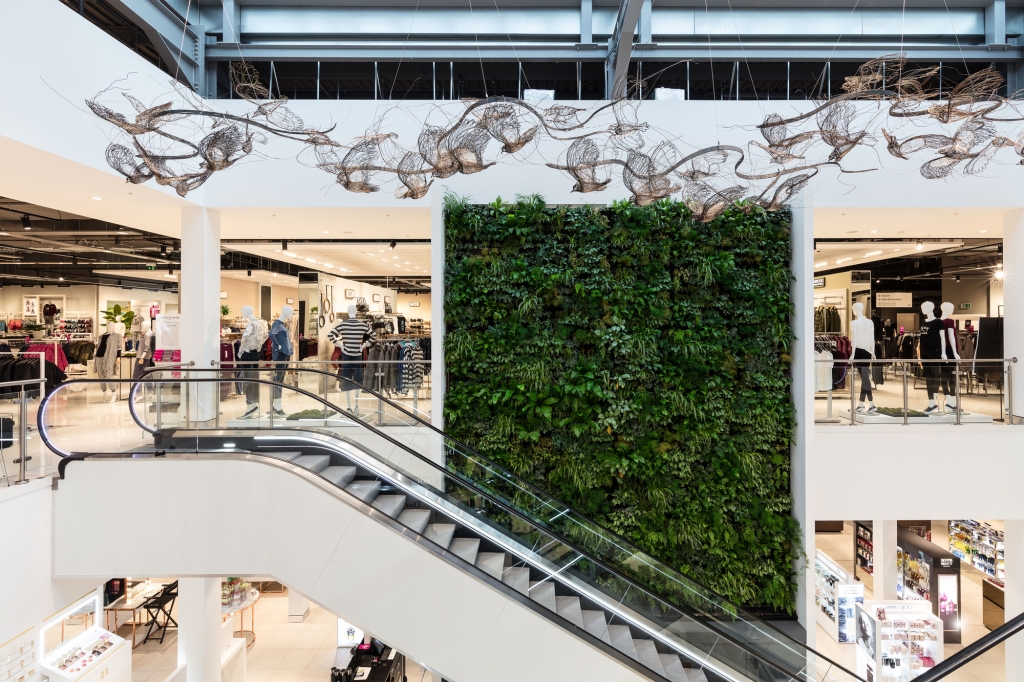

 Headlines7 days ago
Headlines7 days ago
 Headlines2 weeks ago
Headlines2 weeks ago
 Headlines2 weeks ago
Headlines2 weeks ago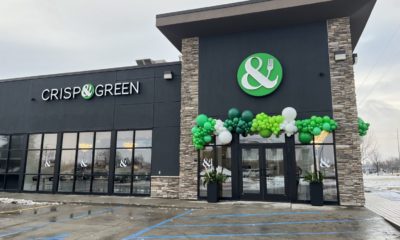
 Headlines2 weeks ago
Headlines2 weeks ago
 John Ryan2 weeks ago
John Ryan2 weeks ago
 Sector Spotlight1 week ago
Sector Spotlight1 week ago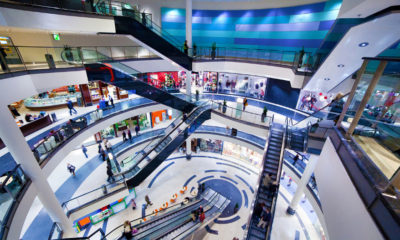
 Headlines2 weeks ago
Headlines2 weeks ago
 Headlines6 days ago
Headlines6 days ago
